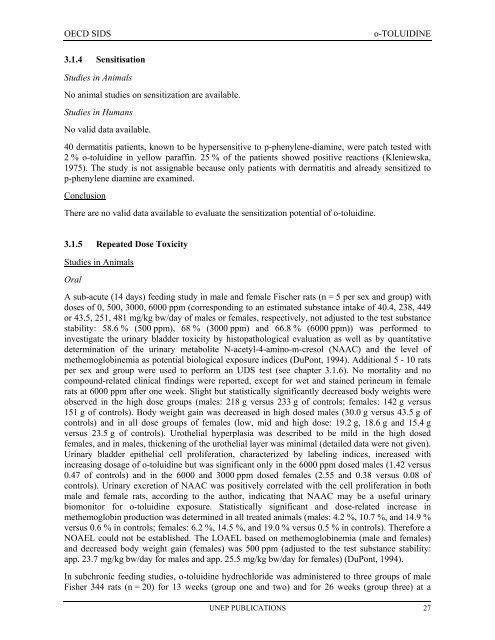o-TOLUIDINE CAS N°: 95-53-4 - UNEP Chemicals
o-TOLUIDINE CAS N°: 95-53-4 - UNEP Chemicals
o-TOLUIDINE CAS N°: 95-53-4 - UNEP Chemicals
You also want an ePaper? Increase the reach of your titles
YUMPU automatically turns print PDFs into web optimized ePapers that Google loves.
OECD SIDS o-<strong>TOLUIDINE</strong><br />
3.1.4 Sensitisation<br />
Studies in Animals<br />
No animal studies on sensitization are available.<br />
Studies in Humans<br />
No valid data available.<br />
40 dermatitis patients, known to be hypersensitive to p-phenylene-diamine, were patch tested with<br />
2 % o-toluidine in yellow paraffin. 25 % of the patients showed positive reactions (Kleniewska,<br />
1975). The study is not assignable because only patients with dermatitis and already sensitized to<br />
p-phenylene diamine are examined.<br />
Conclusion<br />
There are no valid data available to evaluate the sensitization potential of o-toluidine.<br />
3.1.5 Repeated Dose Toxicity<br />
Studies in Animals<br />
Oral<br />
A sub-acute (14 days) feeding study in male and female Fischer rats (n = 5 per sex and group) with<br />
doses of 0, 500, 3000, 6000 ppm (corresponding to an estimated substance intake of 40.4, 238, 449<br />
or 43.5, 251, 481 mg/kg bw/day of males or females, respectively, not adjusted to the test substance<br />
stability: 58.6 % (500 ppm), 68 % (3000 ppm) and 66.8 % (6000 ppm)) was performed to<br />
investigate the urinary bladder toxicity by histopathological evaluation as well as by quantitative<br />
determination of the urinary metabolite N-acetyl-4-amino-m-cresol (NAAC) and the level of<br />
methemoglobinemia as potential biological exposure indices (DuPont, 1994). Additional 5 - 10 rats<br />
per sex and group were used to perform an UDS test (see chapter 3.1.6). No mortality and no<br />
compound-related clinical findings were reported, except for wet and stained perineum in female<br />
rats at 6000 ppm after one week. Slight but statistically significantly decreased body weights were<br />
observed in the high dose groups (males: 218 g versus 233 g of controls; females: 142 g versus<br />
151 g of controls). Body weight gain was decreased in high dosed males (30.0 g versus 43.5 g of<br />
controls) and in all dose groups of females (low, mid and high dose: 19.2 g, 18.6 g and 15.4 g<br />
versus 23.5 g of controls). Urothelial hyperplasia was described to be mild in the high dosed<br />
females, and in males, thickening of the urothelial layer was minimal (detailed data were not given).<br />
Urinary bladder epithelial cell proliferation, characterized by labeling indices, increased with<br />
increasing dosage of o-toluidine but was significant only in the 6000 ppm dosed males (1.42 versus<br />
0.47 of controls) and in the 6000 and 3000 ppm dosed females (2.55 and 0.38 versus 0.08 of<br />
controls). Urinary excretion of NAAC was positively correlated with the cell proliferation in both<br />
male and female rats, according to the author, indicating that NAAC may be a useful urinary<br />
biomonitor for o-toluidine exposure. Statistically significant and dose-related increase in<br />
methemoglobin production was determined in all treated animals (males: 4.2 %, 10.7 %, and 14.9 %<br />
versus 0.6 % in controls; females: 6.2 %, 14.5 %, and 19.0 % versus 0.5 % in controls). Therefore a<br />
NOAEL could not be established. The LOAEL based on methemoglobinemia (male and females)<br />
and decreased body weight gain (females) was 500 ppm (adjusted to the test substance stability:<br />
app. 23.7 mg/kg bw/day for males and app. 25.5 mg/kg bw/day for females) (DuPont, 1994).<br />
In subchronic feeding studies, o-toluidine hydrochloride was administered to three groups of male<br />
Fisher 344 rats (n = 20) for 13 weeks (group one and two) and for 26 weeks (group three) at a<br />
<strong>UNEP</strong> PUBLICATIONS 27
















